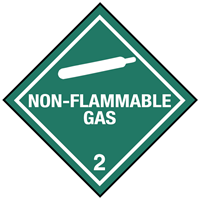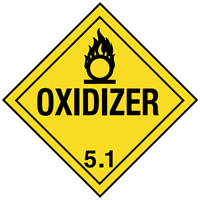Chemical Datasheet
CARBON DIOXIDE AND OXYGEN MIXTURE |


|
Chemical Identifiers
The
Chemical Identifier fields
include common identification numbers, the
NFPA diamond
U.S. Department of Transportation hazard labels, and a general
description of the chemical. The information in CAMEO Chemicals comes
from a variety of
data sources.
| CAS Number | UN/NA Number | DOT Hazard Label | USCG CHRIS Code |
|---|---|---|---|
|
|
|
none |
| NIOSH Pocket Guide | International Chem Safety Card | ||
Carbon dioxide
|
|||
NFPA 704
| Diamond | Hazard | Value | Description | |||||||||
|---|---|---|---|---|---|---|---|---|---|---|---|---|
|
|
3 | Can cause serious or permanent injury. | |||||||||
|
|
0 | Will not burn under typical fire conditions. | ||||||||||
|
|
0 | Normally stable, even under fire conditions. | ||||||||||
|
|
OX | Possesses oxidizing properties. |
Note: NFPA ratings shown are for oxygen, CAS number 7782-44-7.
(NFPA, 2010)
General Description
Carbon dioxide-oxygen mixture is a colorless odorless gas. Both carbon dioxide and oxygen are noncombustible; however, oxygen can accelerate the burning of a fire. Under prolonged exposure to fire or intense heat the containers may rupture violently and rocket.
Hazards
The
Hazard fields
include
special hazard alerts
air and water
reactions, fire hazards, health hazards, a reactivity profile, and
details about
reactive groups assignments
and
potentially incompatible absorbents.
The information in CAMEO Chemicals comes from a variety of
data sources.
Reactivity Alerts
- Strong Oxidizing Agent
Air & Water Reactions
Carbon dioxide is water soluble, and forms carbonic acid, a mild acid in water.
Fire Hazard
No information available.
Health Hazard
No information available.
Reactivity Profile
Pure oxygen is a potent oxidizer. The CO2 is inert, so much of the reactivity of this mixture is connected to the % content of each component. The higher the % content rare gas the less reactive in terms of it being an oxidizing agent. Dusts of magnesium, lithium, potassium, sodium, zirconium, titanium, and some magnesium-aluminum alloys, and heated aluminum, chromium, and magnesium when suspended in carbon dioxide are ignitable and explosive. This is especially true in the presence of strong oxidizers, such as peroxides. The presence of carbon dioxide in solutions of aluminum hydride in ether can cause violent decomposition on warming the residue, [J. Amer. Chem. Soc., 1948, 70, 877]. Dangers arising from the use of carbon dioxide in the fire prevention and extinguishing systems of confined volumes of air and flammable vapors are examined. The hazard associated with its use centers around the fact that large electrostatic discharges may be created that initiate explosion, [Quart. Saf. Summ., 1973, 44(1740, 10].
Belongs to the Following Reactive Group(s)
Potentially Incompatible Absorbents
Use caution: Liquids with this reactive group classification have been known to react with the absorbents listed below. More info about absorbents, including situations to watch out for...
- Cellulose-Based Absorbents
- Expanded Polymeric Absorbents
Response Recommendations
The
Response Recommendation fields
include isolation and evacuation distances, as well as recommendations for
firefighting, non-fire response, protective clothing, and first aid. The
information in CAMEO Chemicals comes from a variety of
data sources.
Isolation and Evacuation
No information available.
Firefighting
No information available.
Non-Fire Response
No information available.
Protective Clothing
No information available.
DuPont Tychem® Suit Fabrics
No information available.
First Aid
No information available.
Physical Properties
The
Physical Property fields
include properties such as vapor pressure and
boiling point, as well as explosive limits and
toxic exposure thresholds
The information in CAMEO Chemicals comes from a variety of
data sources.
Note: For Vapor Density and Specific Gravity, comparing the value to 1.0 can tell you if the chemical will likely sink/rise in air or sink/float in fresh water (respectively). Short phrases have been added to those values below as an aid. However, make sure to also consider the circumstances of a release. The Vapor Density comparisons are only valid when the gas escaping is at the same temperature as the surrounding air itself. If the chemical is escaping from a container where it was pressurized or refrigerated, it may first escape and behave as a heavy gas and sink in the air (even if it has a Vapor Density value less than 1). Also, the Specific Gravity comparisons are for fresh water (density 1.0 g/mL). If your spill is in salt water (density about 1.027 g/mL), you need to adjust the point of comparison. There are some chemicals that will sink in fresh water and float in salt water.
Note: For Vapor Density and Specific Gravity, comparing the value to 1.0 can tell you if the chemical will likely sink/rise in air or sink/float in fresh water (respectively). Short phrases have been added to those values below as an aid. However, make sure to also consider the circumstances of a release. The Vapor Density comparisons are only valid when the gas escaping is at the same temperature as the surrounding air itself. If the chemical is escaping from a container where it was pressurized or refrigerated, it may first escape and behave as a heavy gas and sink in the air (even if it has a Vapor Density value less than 1). Also, the Specific Gravity comparisons are for fresh water (density 1.0 g/mL). If your spill is in salt water (density about 1.027 g/mL), you need to adjust the point of comparison. There are some chemicals that will sink in fresh water and float in salt water.
| Chemical Formula: |
|
Flash Point: data unavailable
Lower Explosive Limit (LEL): data unavailable
Upper Explosive Limit (UEL): data unavailable
Autoignition Temperature: data unavailable
Melting Point: data unavailable
Vapor Pressure: data unavailable
Vapor Density (Relative to Air): data unavailable
Specific Gravity: data unavailable
Boiling Point: data unavailable
Molecular Weight: data unavailable
Water Solubility: data unavailable
Ionization Energy/Potential:
13.77 eV
[From NPG: Carbon dioxide]
(NIOSH, 2024)
IDLH:
40000 ppm
[From NPG: Carbon dioxide]
(NIOSH, 2024)
AEGLs (Acute Exposure Guideline Levels)
No AEGL information available.ERPGs (Emergency Response Planning Guidelines)
No ERPG information available.PACs (Protective Action Criteria)
| Chemical | PAC-1 | PAC-2 | PAC-3 |
|---|---|---|---|
| Carbon dioxide (124-38-9) | 54000 mg/m3 | 72000 mg/m3 | 90000 mg/m3 |
(DOE, 2024)
Regulatory Information
The
Regulatory Information fields
include information from
the U.S. Environmental Protection Agency's Title III Consolidated List of
Lists,
the U.S. Cybersecurity and Infrastructure Security Agency's Chemical Facility
Anti-Terrorism Standards,
and the U.S. Occupational Safety and Health Administration's
Process Safety Management of Highly Hazardous Chemicals Standard List
(see more about these
data sources).
EPA Consolidated List of Lists
No regulatory information available.CISA Chemical Facility Anti-Terrorism Standards (CFATS)
No regulatory information available.OSHA Process Safety Management (PSM) Standard List
No regulatory information available.Alternate Chemical Names
This section provides a listing of alternate names for this chemical,
including trade names and synonyms.
- CARBOGEN
- CARBOGEN 240
- CARBON DIOXIDE AND OXYGEN MIXTURE
- CARBON DIOXIDE AND OXYGEN MIXTURE, COMPRESSED
- CARBON DIOXIDE-OXYGEN MIXT.
- CARBON DIOXIDE-OXYGEN MIXTURE
- OXYGEN AND CARBON DIOXIDE MIXTURE
- OXYGEN AND CARBON DIOXIDE MIXTURE, COMPRESSED
- OXYGEN, MIXT. CONTAINING



